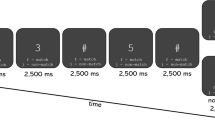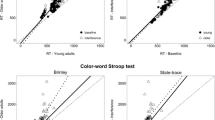Abstract
While concurrent augmented visual feedback of the center of pressure (COP) or center of gravity (COG) can improve quiet standing balance control, it is not known whether such feedback improves reactive balance control. Additionally, it is not known whether feedback of the COP or COG is superior. This study aimed to determine whether (1) concurrent augmented feedback can improve reactive balance control, and (2) feedback of the COP or COG is more effective. Forty-eight healthy older adults (60–75 years old) were randomly allocated to one of three groups: feedback of the COP, feedback of the COG, or no feedback. The task was to maintain standing while experiencing 30 s of continuous pseudo-random perturbations delivered by a moving platform. Participants completed 25 trials with or without feedback (acquisition), immediately followed by 5 trials without feedback (immediate transfer); 5 trials without feedback were completed after a 24-h delay (delayed transfer). The root mean square error (RMSE) of COP–COG, electrodermal level, and co-contraction index were compared between the groups and over time. All three groups reduced RMSE and co-contraction index from the start of the acquisition to the transfer tests, and there were no significant between-group differences in RMSE or co-contraction on the transfer tests. Therefore, all three groups learned the task equally well, and improved balance was achieved with practice via a more efficient control strategy. The two feedback groups reduced electrodermal level with practice, but the no-feedback group did not, suggesting that feedback may help to reduce anxiety.




Similar content being viewed by others
References
Bhatt T, Yang F, Pai Y-C (2012) Learning to resist gait-slip falls: long-term retention in community-dwelling older adults. Arch Phys Med Rehabil 93:557–564
Carlton LG (1981) Processing visual feedback information for movement control. J Exp Psychol 7:1019–1030
Dault MC, Frank JS, Allard F (2001) Influence of a visuo-spatial, verbal and central executive working memory task on postural control. Gait Posture 14:110–116
Diener HC, Horak FB, Nashner LM (1988) Influence of stimulus parameters on human postural responses. J Neurophysiol 59:1888–1905
Hatzitaki V, Amiridis IG, Nikodelis T, Spiliopoulou S (2009) Direction-induced effects of visually guided weight-shifting training on standing balance in the elderly. Gerontology 55:145–152
Huxham FE, Goldie PA, Patla AE (2001) Theoretical considerations in balance assessment. Aust J Physiother 47:89–100
Ioffe ME, Chernikova LA, Umarova RM, Katsuba NA, Kulikov MA (2010) Learning postural tasks in hemiparetic patients with lesions of left versus right hemisphere. Exp Brain Res 201:753–761
King DL, Zatsiorsky VM (1997) Extracting gravity line displacement from stabilographic recordings. Gait Posture 6:27–38
Lafond D, Duarte M, Prince F (2004) Comparison of three methods to estimate the center of mass during balance assessment. J Biomech 37:1421–1426
Lajoie Y (2004) Effect of computerized feedback postural training on posture and attentional demands in older adults. Aging Clin Exp Res 16:363–368
Lakhani B, Mansfield A (2015) Visual feedback of the centre of gravity to optimize standing balance. Gait Posture 41:529–534. doi:10.1016/j.gaitpost.2014.12.003
Lewek MD, Rudolph KS, Snyder-Mackler L (2004) Control of frontal plane knee laxity during gait in patients with medial compartment knee osteoarthritis. Osteoarthr Cartil 12:745–751
Maki BE, McIlroy WE (1996) Influence of arousal and attention on the control of postural sway. J Vestib Res 6:53–59
Maki BE, Whitelaw RS (1993) Influence of expectation and arousal on center-of-pressure responses to transient postural perturbations. J Vestib Res 3:25–39
Masani K, Vette AH, Kouzaki M, Kanehisa H, Fukunaga T, Popovic MR (2007) Larger center of pressure minus center of gravity in the elderly induces larger body acceleration during quiet standing. Neurosci Lett 422:202–206
McIlroy WE, Maki BE (1996) Influence of destabilization on the temporal characteristics of ‘volitional’ stepping. J Mot Behav 28:28–34
McIlroy WE, Maki BE (1997) Preferred placement of the feet during quiet stance: development of a standardized foot placement for balance testing. Clin Biomech 12:66–70
Mochizuki G, Hoque T, Mraz R et al (2009) Challenging the brain: exploring the link between effort and cortical activation. Brain Res 1301:9–19. doi:10.1016/j.brainres.2009.09.005
Osu R, Franklin DW, Kato H, Gomi H, Domen K, Yoshioka T, Kawato M (2002) Short- and long-term changes in joint co-contraction associated with motor learning as revealed from surface EMG. J Neurophysiol 88:991–1004
Pai Y-C, Yang F, Bhatt T, Wang E (2014) Learning from laboratory-induced falling: long-term motor retention among older adults. Age 36:1367–1376
Rose DJ, Clark S (2000) Can the control of bodily orientation be significantly improved in a group of older adults with a history of falls? J Am Geriatr Soc 48:275–285
Sackley CM, Lincoln NB (1997) Single blind randomized controlled trial of visual feedback after stroke: effects on stance symmetry and function. Disabil Rehabil 19:536–546
Sayenko DG, Alekhina MI, Masani K, Vette AH, Obata H, Popovic MR, Nakazawa K (2010) Positive effect of balance training with visual feedback on standing balance abilities in people in incomplete spinal cord injury. Spinal Cord 48:886–893
Sayenko DG, Masani K, Vette AH, Alekhina MI, Popovic MR, Nakazawa K (2012) Effects of balance training with visual feedback during mechanically unperturbed standing on postural corrective responses. Gait Posture 35:339–344
Schmidt RA, Bjork RA (1992) New conceptualizations of practice: common principles in three paradigms suggest new concepts for training. Psychol Sci 3:207–217
Schmidt RA, Lee TD (2011) Motor control and learning: a behavioral emphasis. Human Kinetics, Champaign, IL
Shumway-Cook A, Woollacott MH (2007) Motor control: translating research into clinical practice. Lippincott Williams & Wilkins, Philadelphia
Shumway-Cook A, Anson D, Haller S (1988) Postural sway biofeedback: its effect on re-establishing stance stability in hemiplegic patients. Arch Phys Med Rehabil 69:395–400
Sibley KM, Mochizuki G, Frank JS, McIlroy WE (2010) The relationship between physiological arousal and cortical and autonomic responses to postural instability. Exp Brain Res 203:533–540
Sigrist R, Rauter G, Riener R, Wolf P (2013) Augmented visual, auditory, haptic, and multimodal feedback in motor learning: a review. Psychon Bull Rev 20:21–53
Sihvonen S, Sipilä S, Taskinen S, Pertti E (2004a) Fall incidence in frail older women after individualized visual feedback-based balance training. Gerontology 50:411–416
Sihvonen SE, Sipilä S, Era PA (2004b) Changes in postural balance in frail elderly women during a 4-week visual feedback training: a randomized controlled trial. Gerontology 50:87–95
Tsaklis PV, Grooten WJA, Franzén E (2012) Effects of weight-shift training on balance control and weight distribution in chronic stroke: a pilot study. Top Stroke Rehabil 19:23–31
Van Ooteghem K, Frank JS, Horak FB (2009) Practice-related improvements in postural control differ between young and older adults exposed to continuous, variable amplitude oscillations of the support surface. Exp Brain Res 199:185–193
Van Ooteghem K, Frank JS, Allard F, Horak FB (2010) Aging does not affect generalized postural motor learning in response to variable amplitude oscillations of the support surface. Exp Brain Res 204:505–514
Walker MP, Stickgold R (2006) Sleep, memory, and plasticity. Annu Rev Psychol 57:139–166
Walker C, Brouwer BJ, Culham EG (2000) Use of visual feedback in retraining balance following acute stroke. Phys Ther 80:886–895
Winstein CJ, Schmidt RA (1990) Reduced frequency of knowledge of results enhances motor skill learning. J Exp Psychol Learn Mem Cogn 16:677–691
Winstein CJ, Gardner ER, McNeal DR, Barto PS, Nicholson DE (1989) Standing balance training: effect on balance and locomotion in hemiparetic adults. Arch Phys Med Rehabil 70:755–762
Winter DA (1995) Human balance and posture control during standing and walking. Gait Posture 3:193–214
Winter DA, Patla AE, Prince F, Ishac M, Gielo-Perczak K (1998) Stiffness control of balance in quiet standing. J Neurophysiol 80:1211–1221
Wolf SL, Barnhart HX, Ellison GL, Coogler CE (1997) The effect of Tai Chi Quan and computerized balance training on postural stability in older subjects. Phys Ther 77:371–381
Wright BJ, O’Halloran PD, Stukas AA (2016) Enhancing self-efficacy and performance: an experimental comparison of psychological techniques. Res Q Exerc Sport 87:36–46. doi:10.1080/02701367.2015.1093072
Zatsiorsky VM, Duarte M (1999) Instant equilibrium point and its migration in standing tasks: rambling and trembling components of the stabilogram. Mot Control 3:28–38
Zatsiorsky VM, King DL (1998) An algorithm for determining gravity line location from posturographic recordings. J Biomech 31:161–164
Acknowledgments
This study was supported by the Drummond Foundation. The authors acknowledge the support of the Toronto Rehabilitation Institute; equipment and space have been funded with grants from the Canada Foundation for Innovation, Ontario Innovation Trust, and the Ministry of Research and Innovation. Avril Mansfield is supported by a New Investigator Award from the Canadian Institutes of Health Research (MSH-141983).
Author information
Authors and Affiliations
Corresponding author
Additional information
An erratum to this article is available at http://dx.doi.org/10.1007/s00221-017-4899-2.
Rights and permissions
About this article
Cite this article
Mansfield, A., Aqui, A., Fraser, J.E. et al. Can augmented feedback facilitate learning a reactive balance task among older adults?. Exp Brain Res 235, 293–304 (2017). https://doi.org/10.1007/s00221-016-4790-6
Received:
Accepted:
Published:
Issue Date:
DOI: https://doi.org/10.1007/s00221-016-4790-6




